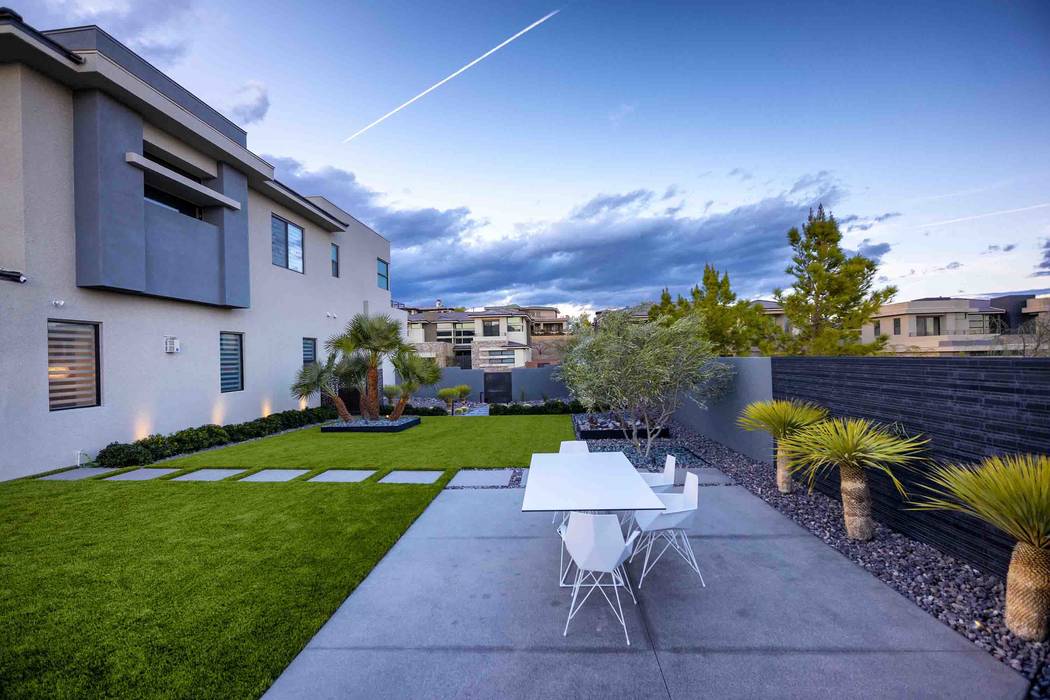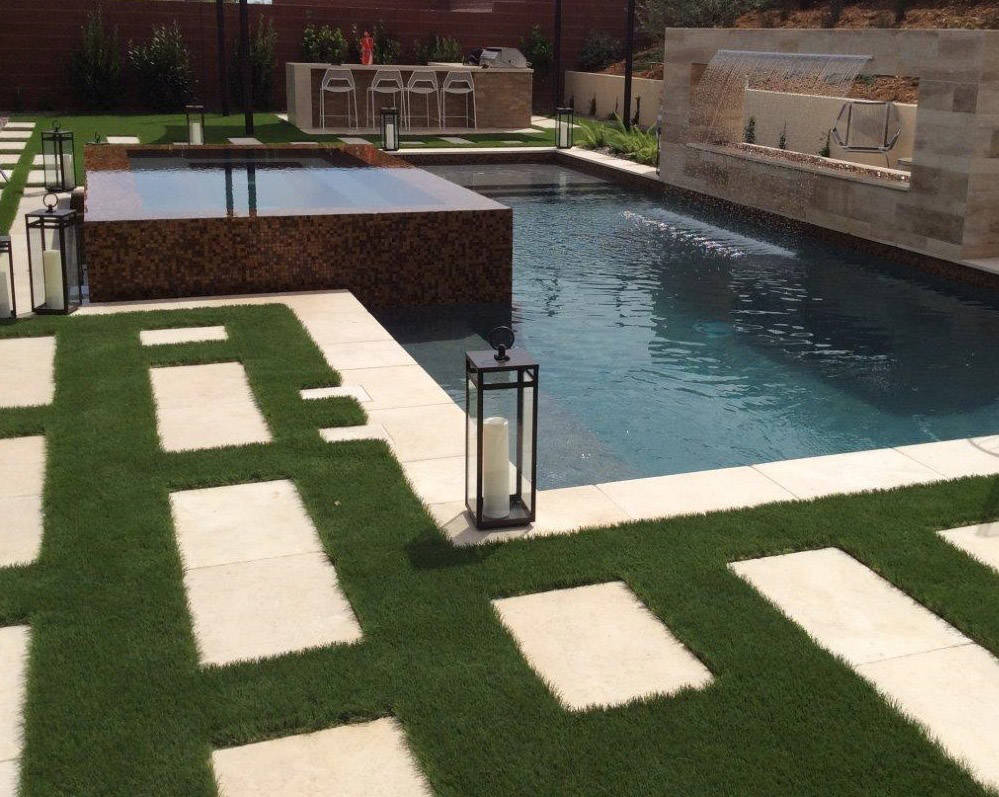Synthetic grass options are better than ever
He’d prefer not to, but Randy Kleiner remembers the days when AstroTurf and synthetic turf were terms used interchangeably. The president of Southwest Greens in Las Vegas has been in the business for more than two decades and remembers those early days when stiff green turf was a weak, carpetlike representation of grass.
Today’s synthetic turf advances have addressed many long-held questions that have plagued them, and many high-quality offerings make it difficult to distinguish them from a rich green fescue grass.
“It has become a very accepted application all across the country,” Kleiner said. “It was frowned upon at first, in those turf days, but today’s products have improved tremendously.”
Synthetic turf isn’t cheap, Kleiner acknowledges, but the long-term maintenance-free part has many people at least considering it for their yards.
“I’d say about 50 percent of my clients will go with synthetic turf,” said Jonathan Spears, a Las Vegas landscape architect and owner of Sage Design Studios. “But it does come down to budget. If the money isn’t there, they may still go with grass, even though they’ll pay for it in watering the lawn all those years.”
Why today’s turf looks so real
Through the years, advances in the needle make-up of synthetic turf have helped create better, more durable and natural-looking offerings. In the past, with AstroTurf, the needles were rigid and stiff, like a credit card, which does not regain its shape after being bent. That is the analogy that Kleiner drew.
Then, manufacturers started creating a “slit film” fiber yarn, which was similar to a needle with a propeller on it. Today’s higher-quality needles are called Omega yarns and allow a manufacturer to combine multiple fibers into one needle in a wide range of shapes. There are dual-fiber and triple-fiber formulations, which give the products a more realistic look.
Southwest Greens carries a product from Shaw Industries called Bolt. Its three-fiber manufacturing method allows for the combination of slit film, monofilament fiber and thatch into one needle, giving it a more natural look with different colors in the turf. The turf materials also rebound better in high-traffic areas, and an occasional once-over with a leaf rake is all it takes to maintain a fresh look.
Spears has used Kleiner’s turf products and also likes SynLawn’s Cashmere 70, which blends field and olive green colors with green thatching for a natural look as well. The product is also durable, Spears said, and works well for playgrounds and play surfaces. Spears also uses local manufacturer Tiger Express for a wide range of turf varieties that look real and bring a high level of durability.
The rubber hits the road
About a decade ago, the norm for filling in a turf surface involved using crumb rubber, black pellet pieces made from old automobile tires. Reports of crumb rubber being linked to cancer arose, but the debate has quieted as full evidence of the link is inconclusive.
Kleiner never used crumb rubber because “it migrates everywhere,” he said. One of the biggest complaints from parents of athletes who played on synthetic turf fields with crumb rubber was the black pellets that would come home with their children. Crumb rubber became a nuisance, and the fact that it was black also meant it retained heat, which wasn’t good for desert environments.
For turf installations in backyards, Kleiner uses a silica sand at 2 pounds per square foot, and crumb rubber isn’t used by any installers he knows of today. He does assert that many installers may not adhere to the 2-pound-per-square-foot rule he does, and that may void warranties on turf products.
“That’s something you have to watch for with contractors. Not all installers have the same standards,” he said. “The same goes with how seams are put together. We glue all our seams. You’ll see a lot of nailed ones coming apart.”
Tackling heat, working with pets
The sand infill won’t make synthetic turf any cooler, Kleiner said. To keep turf cool, he uses HydroChill, a pre-coat he applies to sand infill. HydroChill is activated by water, which it holds and slowly releases over time and keeps a surface 40 to 50 degrees cooler, Kleiner said. Even with this technology, he still advises clients to be strategic with where they install synthetic turf.
“I tell people to plan their yard. Don’t just throw it in one day. Plant trees in the right location. Try to work with natural shade as much as you can and you don’t need to worry about chilling turf,” he said.
For years, pet owners have also shied away from synthetic turf because it trapped urine and left yards smelling bad. Because of this issue, Spears would often tell clients with pets they should plan on replacing their synthetic turf every five years. He still approaches the subject with caution, even though many manufacturers are coming out with lines that breathe better and allow for pet urine to be washed off.
Kleiner said today’s polyethylene yarns don’t absorb water, so the urine will set on the surface. The underlayment also breathes better, allowing for the urine to be rinsed away into the ground.
“I’ve had it in my backyard for nine years, and it never smells. I rinse it every few weeks or a month, and if you’re concerned, I tell people to use vinegar and water once in a while when they rinse it,” he said.
Today, Kleiner has some customers even use turf on side yards for pet runs. For the install, he uses 2 inches of Zeolite rock, which works a lot like a cat litter that allows all ammonia and nitrate to pass through it.
Turf adds design flair
As a landscape designer, Spears appreciates how synthetic turf adds a new dash of creativity to some landscapes. He likes to tuck small swatches of turf between large pavers or use them to break up hardscapes and large sections of concrete.
“There are situations where you don’t really want this large expanse of concrete. Turf breaks it up and makes it a little more intimate,” he said.
With the advances in the technology, he routinely suggests turf for underneath playground equipment and for small open areas that allow for versatile use. Some clients love to use a turf surface for bocce ball games, cornhole, ladder ball and putting greens. With some properties he has worked on that have views of roofs, he has even installed turf on rooftops.
On a more practical note, for families looking to create a play space that may butt up against the home or concrete sitting area, he suggests turf to protect the home or neighboring concrete.
“I’ve seen homes with tremendous damage from sprinklers being too close to the house,” he added.
A low-maintenance synthetic turf that looks like natural grass comes at a price. Kleiner carries eight-year and 15-year warranty products with prices ranging from $5.50 to $7 a square foot. Spears typically sees prices ranging from $6 to $9 a square foot, which, when compared with the roughly 50 cents a square foot for grass, can make it hard on some budgets.
“There are some great products out there, but people do have to consider that cost. For some, there may not be much left for other parts of the yard that they want to work on,” he said.





















